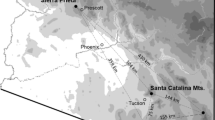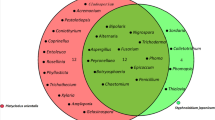Abstract
Foliar fungal endophytes are ubiquitous and hyperdiverse, and tend to be host-specific among dominant forest tree species. The fungal genus Tubakia sensu lato is comprised of foliar pathogens and endophytes that exhibit host preference for Quercus and other Fagaceae species. To clarify interspecific differences in ecological characteristics among Tubakia species, we examined the endophyte communities of seven evergreen Quercus spp. at three sites in eastern Japan during summer and winter. Host tree species was the most significant factor affecting endophyte community composition. Tubakia species found at the study sites were divided into five specialists and three generalists according to their relative abundance in each host species and their host ranges. Specialists were dominant on their own host in summer, and their abundance declined in winter. To test the hypothesis that generalists are more widely adapted to their environment than specialists, we compared their spore germination rates at different temperatures. Spores of generalist Tubakia species were more tolerant of colder temperatures than were spores of specialist Tubakia species, supporting our hypothesis. Seasonal and site variations among Tubakia species were also consistent with our hypothesis. Host identity and ecology were significantly associated with endophyte community structure.







Similar content being viewed by others
Data Availability
Data supporting the findings of this study are available from the corresponding author upon request.
Code Availability
Not applicable.
References
Petrini O (1991) Fungal endophytes of tree leaves. In: Andrews JH, Hirano SS (eds) Microbial Ecology of Leaves. Springer-Verlag, New York, pp 179–197
Arnold A (2007) Understanding the diversity of foliar endophytic fungi: Progress, challenges, and frontiers. Fungal Biol Rev 21:51–66. https://doi.org/10.1016/j.fbr.2007.05.003
Sieber T (2007) Endophytic fungi in forest trees: are they mutualists? Fungal Biol Rev 21:75–89. https://doi.org/10.1016/j.fbr.2007.05.004
Wilson D (1996) Manipulation of infection levels of horizontally transmitted fungal endophytes in the field. Mycol Res 100:827–830. https://doi.org/10.1016/S0953-7562(96)80029-3
Kaneko R, Kaneko S (2004) The effect of bagging branches on levels of endophytic fungal infection in Japanese beech leaves. For Pathol 34:65–78. https://doi.org/10.1111/j.1439-0329.2004.00350.x
Hoffman MT, Arnold A (2008) Geographic locality and host identity shape fungal endophyte communities in cupressaceous trees. Mycol Res 112:331–344. https://doi.org/10.1016/j.mycres.2007.10.014
Suryanarayanan TS, Murali TS, Thirunavukkarasu N et al (2011) Endophytic fungal communities in woody perennials of three tropical forest types of the Western Ghats, southern India. Biodivers Conserv 20:913–928. https://doi.org/10.1007/s10531-011-0004-5
Carroll G, Carroll FE (1978) Studies on the incidence of coniferous needle endophytes in the Pacific Northwest. Can J Bot 3034–3043.
Hata K, Futai K, Tsuda M (1998) Seasonal and needle age-dependent changes of the endophytic mycobiota in Pinus thunbergii and Pinus densiflora needles. Can J Bot 76:245–250
Ortiz-García S, Gernandt DS, Stone JK et al (2003) Phylogenetics of Lophodermium from pine. Mycologia 95:846–859. https://doi.org/10.1080/15572536.2004.11833044
Salas-Lizana R, Santini NS, Miranda-Pérez A, Piñero DI (2012) The Pleistocene glacial cycles shaped the historical demography and phylogeography of a pine fungal endophyte. Mycol Prog 11:569–581. https://doi.org/10.1007/s11557-011-0774-x
Oono R, Lutzoni F, Arnold AE et al (2014) Genetic variation in horizontally transmitted fungal endophytes of pine needles reveals population structure in cryptic species. Am J Bot 101:1362–1374. https://doi.org/10.3732/ajb.1400141
Apigo A, Oono R (2018) Dimensions of host specificity in foliar fungal endophytes. In: Pirttilä AM, Frank AC (eds.) Endophytes of forest trees: biology and applications. Springer International Publishing, pp. 15–42.
Cannon PF, Simmons CM (2002) Diversity and host preference of leaf endophytic fungi in the Iwokrama Forest Reserve, Guyana. Mycologia 94:210–220
Higgins KL, Arnold E, Coley PD, Kursar T (2014) Communities of fungal endophytes in tropical forest grasses: Highly diverse host and habitat generalists characterized by strong spatial structure. Fungal Ecol 8:1–11. https://doi.org/10.1016/j.funeco.2013.12.005
Vincent J, Weiblen G, May G (2016) Host associations and beta diversity of fungal endophyte communities in New Guinea rainforest trees. Mol Ecol 25:825–841. https://doi.org/10.1111/mec.13510
Cohen SD (2006) Host selectivity and genetic variation of Discula umbrinella isolates from two oak species: Analyses of intergenic spacer region sequences of ribosomal DNA. Microb Ecol 52:463–469. https://doi.org/10.1007/s00248-006-9073-5
Vega FE, Simpkins A, Aime MC et al (2010) Fungal endophyte diversity in coffee plants from Colombia, Hawai’i, Mexico and Puerto Rico. Fungal Ecol 3:122–138. https://doi.org/10.1016/j.funeco.2009.07.002
Poulin R, Krasnov BR, Mouillot D (2011) Host specificity in phylogenetic and geographic space. Trends Parasitol 27:355–361. https://doi.org/10.1016/j.pt.2011.05.003
Matsumura E, Fukuda K (2013) A comparison of fungal endophytic community diversity in tree leaves of rural and urban temperate forests of Kanto district, eastern Japan. Fungal Biol 117:191–201. https://doi.org/10.1016/j.funbio.2013.01.007
Osono T, Masuya H (2012) Endophytic fungi associated with leaves of Betulaceae in Japan. Can J Microbiol 58:507–515. https://doi.org/10.1139/W2012-018
Braun U, Nakashima C, Crous PW et al (2018) Phylogeny and taxonomy of the genus Tubakia s. lat. Fungal Syst Evol 1:41–99. https://doi.org/10.3114/fuse.2018.01.04
Yokoyama T, Tubaki K (1971) Cultural and taxonomical studies on the genus Actinopelte. IFO Res Commun 5:43–77
Hashizume Y, Sahashi N, Fukuda K (2008) The influence of altitude on endophytic mycobiota in Quercus acuta leaves collected in two areas 1000 km apart. For Pathol 38:218–226. https://doi.org/10.1111/j.1439-0329.2008.00547.x
Shirouzu T, Hirose D, Fukasawa Y, Tokumasu S (2009) Fungal succession associated with the decay of leaves of an evergreen oak, Quercus myrsinaefolia. Fungal Divers 34:87–107
Matsumura E, Takahashi Y, Fukuda K (2015) Occurrence of endophytic Tubakia spp. in leaves of sympatric evergreen Quercus spp. on Mt. Takao Tree For Heal 19:167–168 (In Japanese)
Murata G (1977) Phytogeographical consideration on the flora and vegetation of Japan. Acta Phytotaxon Geobot 28:65–83. https://doi.org/10.18942/bunruichiri.KJ00003217442 (In Japanese)
Suzuki T (1960) The forest location with the center focus on Japanese oak, Quercus gilva. Japan Soc For Environ 2:1–6 (In Japanese)
Sugiura N, Tang D, Kurokochi H et al (2015) Genetic structure of Quercus gilva Blume in Japan as revealed by chloroplast DNA sequences. Botany 93:873–880. https://doi.org/10.1139/cjb-2015-0025
Urban MC (2015) Accelerating extinction risk from climate change. Science 348:571–573
Harvell CD, Mitchell CE, Ward JR et al (2002) Climate warming and disease risks for terrestrial and marine biota. Science 296:2158–2162. https://doi.org/10.1126/science.1063699
Meteorology division fundamental data development committee of The University of Tokyo Forests (2017) Annual report of meteorological observations in the University of Tokyo Forests, The University of Tokyo (Jan. 2015–Dec. 2015). Tokyo Univ For 59:255–283 (In Japanese)
Hayashi Y, Koyama Y, Kobayashi Y et al (1966) Ecological and floristic studies in the Takao mountains. Bull Gov For Exp Stn 196:1–167 (In Japanese)
Watanabe R, Miyai S (1978) Studies on vegetation in Kiyosumi region: I. Numerical classification of forest vegetation. Japanese J Ecol 28:281–290. https://doi.org/10.18960/seitai.28.4_281
Denk T, Grimm GW, Manos PS, et al. (2017) An updated infrageneric classification of the oaks: Review of previous taxonomic schemes and synthesis of evolutionary patterns. In: Gil-Pelegrín E, Peguero-Pina J, Sancho-Knapik D (eds.) Oaks physiological ecology: exploring the functional diversity of genus Quercus L. Tree Physiology. Springer, Cham, pp. 13–38.
Izumitsu K, Hatoh K, Sumita T et al (2012) Rapid and simple preparation of mushroom DNA directly from colonies and fruiting bodies for PCR. Mycoscience 53:396–401. https://doi.org/10.1007/S10267-012-0182-3
White TJ, Bruns T, Lee S, Taylor J (1990) Amplification and direct sequencing of fungal ribosomal RNA genes for phylogenetics. In: Innis MA, Gelfand DH, Sninsky JJ, White TJ (eds.) PCR Protocols. Academic Press Inc., pp. 315–322.
Kikvidze Z, Ohsawa M (2002) Measuring the number of co-dominants in ecological communities. Ecol Res 17:519–525. https://doi.org/10.1046/j.1440-1703.2002.00508.x
Rohde K (1980) Host specificity indices of parasites and their application. Experientia 36:1369–1371
Iseki R (2018) Anovakun (version 4.8.6). http://riseki.php.xdomain.jp/index.php?ANOVA%E5%90%9B. Accessed 7 November 2021.
Rousseeuw PJ (1987) Silhouettes: a graphical aid to the interpretation and validation of cluster analysis. J Comput Appl Math 20:53–65. https://doi.org/10.1016/0377-0427(87)90125-7
Davis EC, Franklin JB, ShawVilgalys AJR (2003) Endophytic Xylaria (Xylariaceae) among liverworts and angiosperms: phylogenetics, distribution, and symbiosis. Am J Bot 90:1661–1667. https://doi.org/10.3732/ajb.90.11.1661
Kivlin SN, Kazenel MR, Lynn JS et al (2019) Plant identity influences foliar fungal symbionts more than elevation in the Colorado Rocky Mountains. Microb Ecol 78:688–698. https://doi.org/10.1007/s00248-019-01336-4
Darcy JL, Swift SOI, Cobian GM et al (2020) Fungal communities living within leaves of native Hawaiian dicots are structured by landscape-scale variables as well as by host plants. Mol Ecol 29:3102–3115. https://doi.org/10.1111/mec.15544
Oita S, Carey J, Kline I et al (2021) Methodological approaches frame insights into endophyte richness and community composition. Microb Ecol 82:21–34. https://doi.org/10.1007/s00248-020-01654-y
Jumpponen A, Jones KL, David Mattox J, Yaege C (2010) Massively parallel 454 sequencing of fungal communities in Quercus spp ectomycorrhizas indicates seasonal dynamics in urban and rural sites. Mol Ecol 19 Suppl 1 41–53 https://doi.org/10.1111/j.1365-294X.2009.04483.x
Matsumura E, Fukuda K (2015) Fungal endophytic communities in leaves of Quercus myrsinifolia and Eurya japonica: Their within-leaf distributions and antagonism. Tree For Heal 19:195–204 (In Japanese)
Schlegel M, Queloz V, Sieber TN (2018) The endophytic mycobiome of European ash and sycamore maple leaves: geographic patterns, host specificity and influence of ash dieback. Front Microbiol 9:1–20. https://doi.org/10.3389/fmicb.2018.02345
Ohyama M, Baba K, Itoh T (1999) Possibility of grouping of Cyclobalanopsis species (Fagaceae) grown in Japan based on an analysis of several regions of chloroplast DNA. J Wood Sci 45:498–501
Ito S, Ohtsuka K, Yamashita T (2007) Ecological distribution of seven evergreen Quercus species in southern and eastern Kyushu, Japan. Veg Sci 24:53–63
Karabourniotis G, Liakopoulos G, Nikolopoulos D, Bresta P (2020) Protective and defensive roles of non-glandular trichomes against multiple stresses: Structure-function coordination. J For Res 31:1–12. https://doi.org/10.1007/s11676-019-01034-4
Valkama E, Koricheva J, Salminen J-P et al (2004) Leaf surface traits: overlooked determinants of birch resistance to herbivores and foliar micro-fungi? Trees 19:191–197. https://doi.org/10.1007/s00468-004-0380-5
Acknowledgements
We thank Dr. N. Matsushita of The University of Tokyo for assistance with sampling.
Funding
This work was supported by a Japan Society for the Promotion of Science (JSPS) KAKENHI grant (no. JP16H06737).
Author information
Authors and Affiliations
Contributions
All authors contributed to the study conception and design. Sample collection was performed by Kenta Morinaga. Laboratory work and data analyses were conducted by Kenta Morinaga and Emi Matsumura. The first draft of the manuscript was written by Kenta Morinaga and Emi Matsumura. Emi Matsumura and Kenji Fukuda reviewed and edited the manuscript. All authors read and approved the final manuscript.
Corresponding author
Ethics declarations
Ethics Approval
Not applicable.
Consent to Participate
Not applicable.
Consent for Publication
Not applicable.
Conflict of Interest
The authors declare no conflict of interest.
Supplementary Information
Below is the link to the electronic supplementary material.
Rights and permissions
About this article
Cite this article
Matsumura, E., Morinaga, K. & Fukuda, K. Host Specificity and Seasonal Variation in the Colonization of Tubakia sensu lato Associated with Evergreen Oak Species in Eastern Japan. Microb Ecol 86, 240–252 (2023). https://doi.org/10.1007/s00248-022-02067-9
Received:
Accepted:
Published:
Issue Date:
DOI: https://doi.org/10.1007/s00248-022-02067-9




